|
|
 |
|
Calanoida ( Order ) |
|
|
|
Calanoidea ( Superfamily ) |
|
|
|
Megacalanidae ( Family ) |
|
|
|
Bathycalanus ( Genus ) |
|
|
| |
Bathycalanus bradyi (Wolfenden, 1905) (F,M) | |
| | | | | | | Syn.: | no Megacalanus bradyi Wolfenden, 1905 a (p.1, Pl. I: figs.1-6);
Megacalanus princeps : Wolfenden, 1905 a (p.3, Pl.I, figs.7-9);
Bathycalanus maximus Wolfenden, 1906 (p.26, Pl.I: figs.F); 1911 (p.198, figs.F,M);
? Bathycalanus richardi : Jespersen, 1934 (p.45);
Bathycalanus sp. Sewell, 1947 (p.34, juv.5)
Synonymies after Bradford-Grieve & al. (2017, p.84) :
Megacalanus bradyi Wolfenden, 1905 a (p/3, pl.1, figs. 7-8).
Megacalanus princeps : Wolfenden, 1905 b (p.3, pl.1, figs.7-9).
Bathycalanus maximus Wolfenden, 1911 (p.189, pl. XXiii, figs.1-7, text-fig. 2a, b).
Bathycalanus bradyi : Sewell, 1947 (pp 32-34, text-fig. 4). | | | | Ref.: | | | Farran, 1939 (p.360, Rem.); Vervoort, 1946 (p.71, Rem.); Sewell, 1947 (p.32, figs.F); 1948 (p.524); Brodsky, 1950 (1967) (p.98, figs.F); Farran & Vervoort, 1951 a (n°33, p.3); Vervoort, 1957 (p.32, Rem.); 1963 b (p.86, Rem.); Tanaka & Omori, 1967 (p.242, figs.M, Rem.); Brodsky & al., 1983 (p.195, figs.F, Rem.F,M); Chihara & Murano, 1997 (p.834, Pl. 127: F,M); Barthélémy, 1999 a (p.10); | 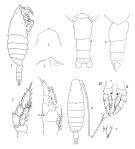 Female: 1, habitus (lateral); 1', P5; Issued from : Sewell R.B.S. in Scient. Rep. John Murray Exped., 1947, 8 (1): 1-303. 2, Head (dorsal); 3, Rostrum (lateral); 4, 4', Urosome (dorsal, lateral); 5, P5; issued from : Brodsky, Vyshkvartseva, Kos & Markhaseva in Opred. Fauna SSSR, 1983, 135: 1-357. Male: 6, habitus (dorsal); Issued from : Farran & Vervoort in Fich. Ident. Zooplankton, 1951, 33: 1-4. 7, 7', P5 (Dt: right, G: left); Issued from : Tanaka & Omori in Inf. Bull. Planktol. Jap., Commemor. Vol. Dr. Y. Matsue, 1967, 239-260. issued from : R.B.S. Sewell in The John Murray Expedition, 1933-34, Scientific Reports, VIII (1), 1947. [p.33, Fig.4]. As Bathycalanus bradyi. Female (fiom G. of Oman): A, habitus (lateral right side); B, P4; C, P5. Nota: Proportional lengths of cephalothorax and abdomen as 76 to 24. The proportional lengths of the various segments of the body (cephalon to caudal rami) as 360:107:73:66:53:79:100:69:45:13:35 = 1000. Head tapered anteriorly and at the extreme anterior end produced in a pair of short horns, immediately below which is a pair of small sensory hairs. On the posterior margin in the mid-dorsal line the cephalon is produced in a bluntly rounded eminence. Rostral processes are sausage-like. Abdomen 4-segmented, anal segment very short. Exopod of P1 is clearly divided into 3 segments, of which the 1st and 2nd are devoid of a marginal spine. Sars (1925, p.16) claims that B. bradyi is identical with that described by him under the name B. richardi. Sewell (1929, p.31; 1932 Pls.I and II ) has recorded the occurrence of Sars' species from the Bay of Bengal, these individuals clearly showing the characteristic fusion of the 2nd and3rd segments in the exopod of P1 in the female. It seems best, as Farran (1939, p.359) has done, to regard the two species as separate, though very closely related.
|
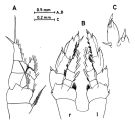 issued from : O. Tanaka & M. Omori in Information Bull on Planktology in Japan. Commemoration Number of Dr. Y. Matsue's Sixtieth Birthday, December 1967. [p.242, Fig.1]. Male (from NW Pacific): A, P1; B, P5 (l = left, r = right); C, distal part of 3rd exopod segment of P5 (left side).
|
 Issued from : K.A. Brodskii in Calanoida of the Far Eastern Seas and Polar Basin of the USSR. Opred. Fauna SSSR, 1950, 35 (Israel Program for Scientific Translations, Jerusalem, 1967) [p.98, Fig.25]. Female (from N Pacif.): habitus (lateral right side); forehead (lateral); R, rostrum (frontal view); Mp1, Mx2; S1, P1.
|
 issued from : R.N. Wolfenden in Die Marinen Copepoden der Deutschen Südpolar-Expedition 1901-1903, 1911. [p.199, Fig.2]. As Bathycalanus maximusFemale: a, habitus (lateral); b, forehead (lateral).
|
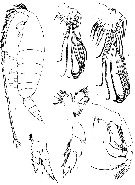 issued from : R.N. Wolfenden in Die Marinen Copepoden der Deutschen Südpolar-Expedition 1901-1903, 1911. [Pl.XXIII, Figs.1-7]. As Bathycalanus maximus. Female: 3, Mx2; 4, Mx1; 5, Mxp; 7, P1. Male: 1, habitus (lateral); 2, Mx2; 6, P5.
|
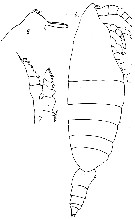 issued from : R.N. Wolfenden in Plankton Studies Part I. Copepoda. 1905 [Pl. VIII, 6-8]. As Bathycalanus maximus. Female: 6, habitus (lateral); 7, P1; 8, forehead (lateral).
|
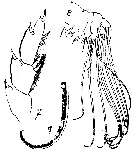 issued from : R.N. Wolfenden in Plankton Studies Part I. Copepoda. 1905 [Pl. I, 7-9]. Female: 7, P5; 8, Mx2; 9, detail of distal part of bristle of Mx2.
|
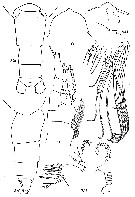 issued from : K.A. Brodsky, N. V. Vyshkvartzeva, M.S. Kos & E.L. Markhaseva in Opred . Faune SSSR, 1983, 135 (1). [p.195, Fig.86]. Female. R = forehead with rostrum; Ce = forehead (dorsal); Abd = last thoracic segment and urosome. Mx2 after Wolfenden, 1911; remaining figures: specimen from Bering Sea. Nota: - Genital segment amphora-like. - Exopod of P1 with 3-segmented.
|
 issued from : R.-M. Barthélémy in These Doct. Univ. Provence (Aix-Marseille I), 1999. [Fig.20, A]. Female (from Antarctic): A, external ventral view genital double-somite. go = genital operculum. Scale bar: 0.500 mm.
|
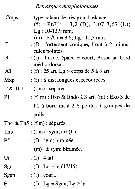 Issued from : C. Razouls in Ann. Inst. océanogr., Paris, 1994, 70 (1). [p.36]. Caractéristiques morphologiques de Bathycalanus bradyi femelle et mâle adultes. Terminologie et abbréviations: voir à Calanus propinquus.
|
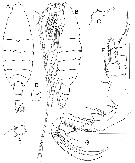 Issued from : J.M. Bradford-Grieve, L. Blanco-Bercial & G.A. Boxshall in Zootaxa, 2017, 4229 (1). [p.86, Fig.47]. Female (from 23.240°S, 08.238°E): A-B, habitus (dorsal and lateral, respectively); C, forehead (lateral); D, genital double-somite (ventral); E, caudal ramus ( dorsal); F, P1 (anterior view); G, Mxp. Scale bars; 1.0 mm on all figures. Nota: - Anterior head in dorsal view with rounded prominence extending into pair small anteriorly-directed divergent spine-like processes; - Pedigerous somite 5 with symmetrical, short, rounded posterolateral corners extending 1/4 of way along genital double-somite. - Genital double-somite symmetrical in dorsal view, about as long as wide, with small anteroventral genital operculum, seminal receptacles not observed. - A1 extending about 6 segments beyond caudal rami. - Mxp syncoxal endite 4 with longest spinulose seta extending to distal border or beyond, of endopod segment 2; endopod segments 3-6 with 4 (3 very short), 3 (2 short) + 1 outer, 3 setae (1 short) + 1 outer seta, respectively. - P1 exopod with articulation between exopod segments 2 and 3 expressed, exopod segment 3 with 1 distal outer spine.
|
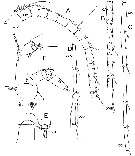 Issued from : J.M. Bradford-Grieve, L. Blanco-Bercial & G.A. Boxshall in Zootaxa, 2017, 4229 (1). [p.87, Fig.48]. Female: A, A1 ancestral segments I-XIV; B, A1 ancestral segments XV-XVIII; C, A1 ancestral segments XIX-XXIII; D, A1 ancczstral segments XXIV-XXVIII; E, detail of ancestral segment XXVIII; F, A2; . Scale bars: 1.0 mm (A-D); 0.1 mm (E, F). Nota: - A1: ancestral segments XII-XVII sometimes with surface thickenings but not always. Anterior and posterior borders of ancestral segments XVI-XXI smooth. - A2 exopod segment IV with short seta extending to distal border of segment VIII, lined with spinules.
|
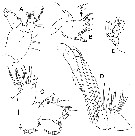 Issued from : J.M. Bradford-Grieve, L. Blanco-Bercial & G.A. Boxshall in Zootaxa, 2017, 4229 (1). [p.88, Fig.49]. Female: A, Md palp; B, Md gnathobase; C, Mx1; D, Mx2; E, detail of inner view of endopod of Mx2. Scale bars: 1.0 mm (D); 0.1 mm on remaining figures. Nota: - Mx1 praecoxal arthrite (formerly inner lobe 1) with 13 setae and spines, including 2 setae on posterior surface; coxal endite (formerly inner lobe 2) without setae; basal endite 2 (formerly inner lobe 3) with 3 short setae; endopod segments 2 with 2 (subequal), 2 (subequal), 6 setae (1 smaller one arising from posterior surface), respectively.
|
 Issued from : J.M. Bradford-Grieve, L. Blanco-Bercial & G.A. Boxshall in Zootaxa, 2017, 4229 (1). [p.89, Fig.50, A-E]. Female : A, P2; B, P3; C, P4; D, P5; (all legs in anterior view); E, detail of outer border of exopod segment 2 of P2. Nota: P2-P5 exopod surfaces usually bearing small thickenings.
|
 Issued from : J.M. Bradford-Grieve, L. Blanco-Bercial & G.A. Boxshall in Zootaxa, 2017, 4229 (1). [p.89, Fig.50, F-K]. Male (from20.933°N, 138.533°E): F-G, habitus (dorsal and lateral, respectively); H, forehead (dorsal view); I, same (lateral); J, caudal ramus (dorsal view); K, coxal endite (C), basal endites 1 and 2 (B1, 2), endopod segments 1 and 2 (Ri1, 2) of Mx1; Scale bars: 1.0 mm (F, G); 0.1 mm (I, J, K). Nota: - Anterior head in dorsal view with low rounded prominence extending into pair of small, slightly divergent, anteriorly-directed spine-like processes and parallel sided rostral filaments. - Pedigerous somite 5 with short, rounded posterior lappets not extending as far as posterior border of urosomite I. - Urosomal measurements made in lateral view (see below fig.1, D and tabuled in Table 9): Urosomite II not enlarged and swollen: Ur II 1.54-1.80 (mean = 1.64, SD = 0.10, n = 5) times longer than Ur III and not constricted anteriorly such that ratio Ur II ant/Ur II mx = 0.79-0.85 (mean = 0.82, SD = 0.02, n = 5).
|
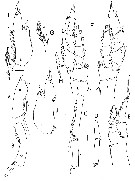 Issued from : J.M. Bradford-Grieve, L. Blanco-Bercial & G.A. Boxshall in Zootaxa, 2017, 4229 (1). [p.90, Fig.51]. Male: A, A1 ancsetral segment XIX; B, A1 ancestral segment XX; C, ancestral segments XXI-XXIII; D, A1 ancestral segments XXVI-XXVIII; E, P1 (anterior view); F, P5 (anterior view); G, detail of left inner distal corner of exopod segment 2; H, detail of outer border of exopod segment 1; I, left exopod segment 3 of P5 (from another specimen); J, detail of right rxopod segment 3 of P5 (from anorger specimen). Scale bar: 0.1 mm on all figures. Specimen from 06.000°N, 122.600°E: figures A-D ; from 20.933°N, 138.533°E: figures E-H; from 13.155°S, 0.316°E: I, J. Nota: - A1 not well known as specimens damaged. Left A1 illustrated by Wolfenden (1911) as Bathycalanus maximus reaches beyond caudal rami. Some parts of right A1 (similar to those of Ba richardi were present in specimen from 06°00N, 122.60°E, but this specimen was atypical in that it did not have thickenings on leg exopods. - A2, Md, Mx1, Mxp and P1 to P4 similar to those of female. - P5 basis with long setules on inner distal border. Exopod segments 1-3 with thickenings on outer cuticle. Left exopod segment 2 specialised seta with long lash extending almost to distal border of endopod segment 3, basal part rectangular in shape with outer distal spine. Left exopod segment 3 with inner spine inserted opposite 1st outer border spine, inner border of segments proximal to inner spine entirely lined with long setules. Right exopod segment 3 with inner spine inserted just proximal to level of insertion of 1st outer spine, inner border mostly naked apart from short region of setules proximally.
|
 Issued from : J.M. Bradford-Grieve, L. Blanco-Bercial & G.A. Boxshall in Zootaxa, 2017, 4229 (1). [p.91, Table 10]. Morphological characters after identification key of Bathycalanus females and males. Compare to other species of genus. Main characters identification after species key : 1 - Mx1 praecoxal endite without setae. 2 - Anterior margin of head with 2 very small spine-like processes. 3 - P1 exopod segments 2 and 3 separate; 4 - Pedigerous somites 4 and 5 without laterally extended lappets; Genital double not angular shaped. 5 - Genital double-somite hardly swollen in dorsal view, without spinules. (male unknown). 6 - Pedigerous somite 5 hardly extended posteriorly, symmetrical, short and rounded in lateral view. 7 - Female A1 ancestral segments XII-XVIII without bordering teeth, may be covered or partly covered in thickenings. Male P5 left exopod segment 2 specialised seta extended to distal border of endopod, right P5 exopod segment 3 inner border with small patch of proximal spinules.
|
 Issued from : J.M. Bradford-Grieve, L. Blanco-Bercial & G.A. Boxshall in Zootaxa, 2017, 4229 (1). [p.82, Table 9]. Proportions of male urosomites. See below diagram illustrating how measurements were made (Fig.1, D). Stations: MV66-11 = 38.033°N, 124.183°W; Antipode IV Stn 55D = 20.933°N, 138.533°E; Circe II = 06.000°N, 122.600°E; ; ANTXIV/1 Stn 4 =
|
 Issued from : J.M. Bradford-Grieve, L. Blanco-Bercial & G.A. Boxshall in Zootaxa, 2017, 4229 (1). [p.13, Table 1, D]. Diagram illustrating measurements. Example taken for Bathycalanus bradyi in lateral view.. male. Ur = urosomite
| | | | | Compl. Ref.: | | | Grice, 1963 a (p.495); Grice & Hulsemann, 1968 (tab.2); Lee & al., 1971 (p.1151); Björnberg, 1973 (p.303, 384); Childress, 1975 (p.787, respiratory rate); Hopkins & Torres, 1988 (tab.1); Razouls & al., 2000 (p.343, tab. 5, Appendix); Ikeda & al., 2006 (p.1791, Table 2); Galbraith, 2009 (pers. comm.); Park & Ferrari, 2009 (p.143, Table 4, Appendix 1, biogeography) | | | | NZ: | 14 | | |
|
Distribution map of Bathycalanus bradyi by geographical zones
|
| | | | | | | | | 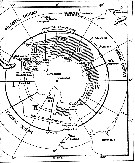 issued from : W. Vervoort in B.A.N.Z. Antarctic Reseach Expedition, Reports - Ser. B, Vol. III, 1957 [Fig.7]. issued from : W. Vervoort in B.A.N.Z. Antarctic Reseach Expedition, Reports - Ser. B, Vol. III, 1957 [Fig.7].
Chart showing the geographical distribution (white triangle) in the seas surrounding the Antarctic continent.
Nota: In this chart the area frequented by whaling vessels has been hatched. The Antarctic circle (66°.5 S) has been drawn as a broken line. The numbers I to VI refer to the sectors into which the Antarctic seas are divided according to Mackintosh (1942) (after Vervoort, 1951). |
 Issued from : J.M. Bradford-Grieve, L. Blanco-Bercial & G.A. Boxshall in Zootaxa, 2017, 4229 (1). [p.84, Fig.46]. Issued from : J.M. Bradford-Grieve, L. Blanco-Bercial & G.A. Boxshall in Zootaxa, 2017, 4229 (1). [p.84, Fig.46].
Distribution of Bathycalanus species;
Bathycalanus richardi (filled squareç; Bathycalanus bradyi (filled triangle); Bathycalanus milleri (open triangle); Bathycalanus dentatus (open square); Bathycalanus tumidus (open circle); Bathycalanus adornatus (open diamond); Bathycalanus pustulosus (filled star); Bathycalanus unicornis ( (filled diamond); Bathycalanus bucklinae (filled circle); Bathycalanus eximius (cross). |
| | | | Loc: | | | Antarct. (Peninsula, Drake Passage, Weddell Sea, Indian), sub-Antarct. (SE Pacif.), South Africa, off Tristan da Cunha E, off Ste Hélène, G. of Guinea, Cape Verde Is., ? Davis Strait (in Jespersen, 1934), W Iceland, Faroe Is., G. of Oman, Indian (W & NW), Indonesia-Malaysia, Japan, NW Pacif., off British Columbia, S California, off Juan Fernandez Is., S Chile | | | | N: | 19 | | | | Lg.: | | | (10) F: 12-10,9; (11) F: 11,93; (14) F: 9,9-8,9; (22) F: 13; (25) F: 11,6; (70) F: 13,9-13,3; M: 11,3; (131) F: 13,9-8,9; M: 10-8,5; (787) F: 13-10; M: 9,5; (866) M: 10-12; (1316) F: 9,2-13,0; M: 8,4-10,1; {F: 8,90-13,90; M: 8,40-12} | | | | Rem.: | meso-bathy-abyssopelagic.
Sampling depth (Antarct., sub-Antarct): 0-1000 m.
For Vervoort (1963 b, p.86- the Atlantide specimens have been brought to this species because of the 3-segmented exopod of P1; the 4th and 5th thoracic somites, however, are separate. The Atlantide specimens agree with those from the Gulf of Oman, Arabian Sea, recorded by Sewell (1947) and from Indian sector of the Antarctic (Vervoort, 1957). The geographical distribution of this deep water species seems to be much wider than appears from previously publised records.
For Vervoort (1957, p.32) the principal difference between this species and B. richardi being the fact that in the former the 2nd and 3rd segments of the exopods of P1 are separate, while in B. richardi these segments are fused. Wolfenden (1905, 1911) also mentions the fusions of the 4th and 5th thoracic somites in B. bradyi.
H.B. Michel (1994, p.185) regards Bathycalanus bradyi as a synonym of Bathycalanus richardi, certain populations of which incompletely develop the disyal septum which defines the middle segment of the exopod on P1.
R. Stephen: Data sheets of NIO, Kochi, India (on line).
After bradford-Grieve & al. (2017, p.87), Farran (1939, p.357) points out that the specimens that Wolfenden (1905 a) named Megacalanus bradyi Wolfenden, 1905 stand as a valid description of a species, clearly a Bathycalanus, that differs from bathycalanus richardi in having a 3-segmented P1 exopod. In 1911, Wolfenden described Bathycalanus maximus, clearly the same species as the specimens recorded by the authors. Wolfenden's (1911) figure of the maxillae (pl.23, fig.4) and male left P5 (pl.23, fig.6) agree with the specimens of the authors. Also the urosome of the male (illustrated pl.23, fig.1) has similar proportions to the males described by the authors in that they do not have the elongate, anteriorly constricted, swollen urosomite II typical of Bathycalanus richardi. Wolfenden (1911) does not mention the distinctive thickenings usually present on the female A1 ancestral segments XII-XVII or legs..For Bradford-Grieve & al. (2017, p.88) that what is called Bathycalanus bradyi may be a complex of mote than one species. Not only is there morphological variation but the molecular data are also ambiguous. The molecular data suggest a couple of clades may exist in the bathycalanus bradyi data and one specimen of the species (Bathycalanus adornatus n. sp.) also groups with one of these clades. These observations suggest that the gene regions employed in the study by the authors are not sufficient to distinguish species unambiguously in Bathycalanus. | | | Last update : 31/07/2018 | |
|
|
 Any use of this site for a publication will be mentioned with the following reference : Any use of this site for a publication will be mentioned with the following reference :
Razouls C., Desreumaux N., Kouwenberg J. and de Bovée F., 2005-2025. - Biodiversity of Marine Planktonic Copepods (morphology, geographical distribution and biological data). Sorbonne University, CNRS. Available at http://copepodes.obs-banyuls.fr/en [Accessed October 22, 2025] © copyright 2005-2025 Sorbonne University, CNRS
|
|
 |
 |





















